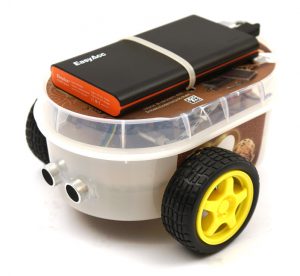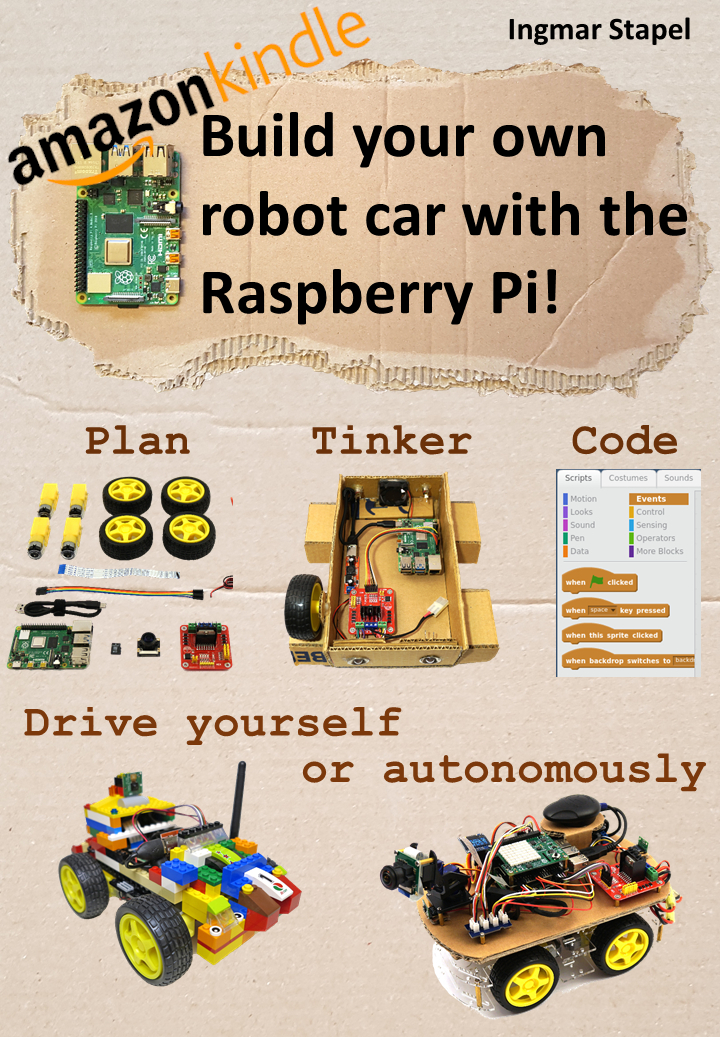I have been building model robot cars based on the Raspberry Pi for many years and have built up a broad knowledge in this field of robotics and electronics. With this knowledge and my enthusiasm for robot cars a book has been created which has already been published in the 2nd edition. Furthermore I have given several lectures and have contact to teachers who build robot cars with their students. I was confronted with the problem of the teachers that the robots on Raspberry Pi basis are still too expensive for parts of the students and their parents. Many parents are willing to give their children a smartphone for more than 500,-€ but 50,- € to 90,-€ for a robot car project in school are far away from the imaginable. Therefore there is a need to design the robot cars much cheaper than it is possible with a Raspberry Pi.
So I had the idea to design a robot car that costs less than 10,-€ and can still be remote controlled via smartphone. The limitation is that no Raspberry Pi can be used anymore and therefore you have to change to a cheap microcontroller. With the cost of 10,-€ for the robot car it is assumed that the electronics will be ordered directly in China from e.g. Ali-Express and then also in quantities of at least 20 units. Otherwise, the 10,-€ for a model cannot be kept in China even with a direct order. If you buy the components individually, e.g. at Amazon, the costs for this model will quickly amount to about 30,-€ to 40,-€.
The robot car I built according to these specifications looks like the following picture.
With the goal to build a cheap robot I started to search for the components together in the basement of my home. So I created this little robot whose construction and programming I will describe in a small article series here on my blog.
Beside the Raspberry Pi there is also the Arduino which is also used for handicraft projects. Because the Arduino does not have W-LAN and I want to build a maximum cheap robot I will use the popular ESP8266 NodeMCU developer board for this robot which has a WIFI module and antenna. The ESP8266 chip can be programmed like an Arduino and also offers a variety of interfaces. The advantage of the ESP8266 is that almost all libraries available for the Arduino can be executed and used on this small chip. This opens up a lot of possibilities for the use of sensors, for example, when building a robot car.
The video shows the finished robot driving through the apartment.
The following picture shows an ESP8266 NodeMCU with its GPIO pin connections on the left and right, the USB interface at the bottom of the picture, and the ESP8266 chip (in silver) on top of the board. Also visible above the chip is the W-LAN antenna which is mounted directly on the board. With this antenna it will be possible to control the robot later via smartphone and a small web interface.
Also, ESP8266 is very well designed in terms of its memory space for self-written programs. The CPU speed is ideal for the small robot car project and is quite sufficient. Thanks to the many interfaces and the built-in voltage converter, the robot car can be easily extended with sensors. The robot can be powered once with a normal power bank or with six AA batteries and a step-down converter. The cost of 10,- € does not include the Power Bank or the batteries but the cheapest way is to use the six Mignon batteries. Nevertheless, it is possible to build up the robot individually depending on your interests, available budget and the task at hand.
The article series will go into the electronics as far as necessary to understand how everything is assembled. However, not everything is described in detail as I do not consider this necessary to build the robot to make it work. If you want to go deeper into the topic of robotics and electronics with the Arduino you can buy the following book which describes the world of the Arduino in detail.
The goal of this project is to keep the cost of the robot car below 10,-€. To keep the costs as low as possible, the components have to be purchased directly in China. This is no problem at all in my experience. Only the delivery time of up to 4 weeks has to be taken into account when implementing the project.
Summary
With the ESP8266 NodeMCU development board, which can be purchased for less than 2,- € in China, it is possible to build a very cheap robot. Since the ESP8266 NodeMCU is already equipped with WIFI and the GPIO connectors have been brought out, the assembly and wiring of the individual components is simplified considerably. Another big advantage is the proximity to the Arduino and that the ESP8266 is directly supported by the Arduino IDE and many libraries.
Article Overview ESP8266 NodeMCU Robot Car:
Building robots with the ESP8266 development board – IntroductionBuilding robots with the ESP8266 development board – Power supply
Building robots with the ESP8266 development board – Components
Building robots with the ESP8266 development board – chassis
Building robots with the ESP8266 development board – Wiring Part 1
Building robots with the ESP8266 development board – Wiring Part 2
Building robots with the ESP8266 development board – Setting up the Arduino development environment
Building robots with the ESP8266 development board – Ultrasonic sensor and motor control
Building robots with the ESP8266 development board – WIFI remote control
Building robots with the ESP8266 development board – servo motor control
Building robots with the ESP8266 development board – OLED display
Building robots with the ESP8266 development board – Magnetometer
Building robots with the ESP8266 development board – GPS receiver introduction
Article Outlook:
Building robots with the ESP8266 development board - GyroscopeBuilding robots with the ESP8266 development board - GPS waypoints
Building robots with the ESP8266 development board - Solar cell












Recent Comments